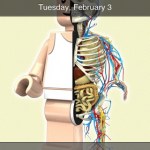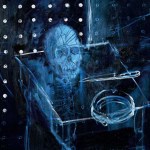Medical Illustration and History
Artist Jason Freeny asks us to suspend our disbelief for this mashup of two of my favorite things ever: anatomy and Lego. Surprisingly, after ripping the interchangeable heads and legs off hundreds of Lego people during my misspent youth, I find I can almost believe they *are* alive.
You can order Jason's poster here - he has also created posters for gummy bear anatomy and balloon animal anatomy. These would be excellent additions to a physiology teaching lab. Plus, Jason has created a free iPhone wallpaper of the Visible Lego Man, which is now on my phone:
Thanks, Jason!
While I was at work, Sciencepunk beat me to posting that Damien Hirst (of dead-shark fame) has created an original artwork for the anniversary reissue of Darwin's On the Origin of Species:
Human skull in space (oil on canvas)
Damien Hirst
Hirst says:
As in a lot of my work, there's a nod to the scientific. The painting sits firmly in the tradition of "still life" and is made up of objects I've come to imbue with my own meanings, some of them Darwinian in origin, and that I guess are seen in other areas of my work. The painting has an X-ray-like quality to it, as if it is revealing something…
Without Hope
Frida Kahlo, 1945
Museo Dolores Olmedo Patino, Mexico City
I ran across an extremely interesting article by Richard and Maureen Park in the December BMJ. It focuses on the decidedly unfestive procedure of force-feeding via funnel, and how that medical procedure has been represented in art. I don't think I've ever really thought about this topic before in a medical context.
The term "gavage," from the French "to gorge," is used to describe the force feeding of ducks and geese for the production of pâté de foie gras using funnels. For many centuries funnels have also been…
These charming photos by bre pettis capture a lovely, detailed diorama at the Natural History Museum in Vienna. I'm not sure how old it is, but it's very cool.
This cake, complete with circulatory and musculoskeletal diagrams, is pretty amazing. (I'd like to give one to my friend Rhett to celebrate his admittance to an excellent medical school.)
Via shewalkssoftly
Apparently Winston Churchill was not the greatest poet at 15 (but then, who is? Keats churned out some horrible clunkers[1] when young). In this month's BMJ, Angus Nicholl and colleagues call our attention to Churchill's classically influenced poem "The Influenza". (No, it's not actually called "Ode to Flu" - but it might be cooler if it was).
Nicholl and colleagues give Churchill credit for accurately reflecting the geography and seasonality of the 1890-1 Russian flu pandemic. Churchill's teachers at Harrow School gave him a prize. I give him a big eye-roll, and that's generous ("And now…
Illustration by John George
From Opera Chirurgica by Hieronymus Fabricius, 1684
From Sothebys via Bibliodyssey
When I saw this illustration over at Bibliodyssey, the first thing I thought of was the creepy Nazi henchman Kroenen in the film Hellboy. Shiver! But apparently it's a medical device - a full-body splinting apparatus. (At least, it's a concept drawing for such a device, since as Peacay points out, you probably wouldn't survive injuries extensive enogh to require full-body splinting in 1684.)
"Please Hug Me"
artist: J. Keeler, 1987
Today is the 20th annual World AIDS Day. I can still remember when I first learned about AIDS, in the late eighties - it was an extremely scary and mysterious thing that the media seemed very uncomfortable covering. No one I knew was talking about it openly - family, friends, or teachers. That's why posters like this were so important.
AIDS awareness advertisements represent a history of creative and controversial images - largely because of their sometimes explicit* sexual content, but also because of the stigmas attached to STDs, casual sex, and…
Ephraim Chambers
Cyclopaedia, 1728
Via Morbid Anatomy, some beautiful detail images from Ephraim Chambers' Cyclopaedia:
Cyclopaedia: or, A Universal Dictionary of Arts and Sciences (folio, 2 vols.) was an encyclopedia published by Ephraim Chambers in London in 1728, and reprinted in numerous editions in the 18th century. The Cyclopaedia was one of the first general encyclopedias to be produced in English. (source: Wikipedia
Read more at Morbid Anatomy.
The Moment of Conception and Ensoulment
Illumination from Jean Mansel, Vie de Nostre Seigneur Jesus Christ,
fifteenth century, fol. 174. 11.1 x 15.8 cm.
Bibliotheque Nationale, Paris
From "Making Visible Embryos"
Via the invaluable Morbid Anatomy, I discovered a remarkable new website, "Making Visible Embryos." Assembled by Tatjana Buklijas and Nick Hopwood of the University of Cambridge, with the support of the Wellcome Trust, it traces the evolution of our understanding of the human embryo, beginning with an unexplored mystery within the inaccessible womb, through epigenesis and…
Chesterfields ad, 1952
Today, November 20, is the American Cancer Society's 33rd Great American Smokeout. Now, be honest: did you even know?
The Smokeout doesn't seem to get as much attention as it used to, perhaps because the link between cigarette smoke and cancer is no longer surprising or controversial. After decades of anti-tobacco campaigns hammering the research home, no media-conscious American could plausibly believe that cigarettes are actually good for his or her health. Yet this is a sea change from attitudes in the first half of the 20th century, when cigarettes' health…
Next week, PBA galleries in San Francisco will be auctioning rare books, prints, and ephemera from the medical library of Gerald I. Sugarman, MD. Joanna at Morbid Anatomy has distilled some of the best medical illustrations from this collection into two posts here and here. Thanks, Joanna!
This is wonderful stuff. I think Dr. Sugarman must have been an interesting character. . . the kind of guy I wish lived down the hall from me so I could borrow his books.
From "A System of Anatomy" by Samuel Collins, 1685
From "Anatomia Corporum Humanorum" by Joannem Arnoldum Langerak, 1739
This article originally appeared on the old bioephemera September 9, 2007.
Syphilitic skull with three trephine holes and osteomyelitic lesions
Hunterian museum
One of my favorite London experiences was my visit to the Hunterian museum. If only I had more time there! I liked it so much, I returned on my last day, procrastinating my departure for Heathrow as long as possible.
The Hunterian is tucked away inside the Royal College of Surgeons of England, on Lincoln's Inn Fields. In its Victorian incarnation, it was a wonderful multi-tiered gallery with railings, balconies, and suspended…
De prospectiva pingendi, Book 3, figure lxiv
Piero della Francesca (c 1412-92)
This month's Lancet has an interesting article by G.D. Schott, linking Piero della Francesca's pioneering orthographic projections to technologies like fMRI:
In the neurosciences today, images of the brain and its constituent structures are typically presented in the triadic orthogonal format, comprising coronal, sagittal, and axial projections. Less commonly, rotated or tilted projections are used. But our forebears are easily forgotten, and here I suggest that the contemporary way in which brain images are…
For some reason, Ben Folds has decided to make giant rotating skulls and brains part of his latest tour - this is the scene on stage last night in DC. There was a "brainwashing" theme in the first few songs, and I think that guided the choice of images, but darn, it was kinda weird!
Vernon Grant, 1944
If you enjoyed the vintage public health posters I wrote about a while ago, you might want to stop in and see the National Academies' new exhibition, "An Iconography of Contagion." (Such a great title!)
Over twenty public health posters from 1920-1990 will be on display until December 19. Michael Sappol of the National Library of Medicine (and curator of Dream Anatomy) will give a free gallery talk tonight at 6pm.
Skeleton appetizer plates
Pottery Barn
I usually just toss my Pottery Barn catalogs, because I no longer have a house to decorate. But the Halloween edition just arrived and there's some good medical-specimen stuff in there. In addition to the skeleton appetizer plates above, which I totally covet, they have a skull tray, vampire teeth placeholders, and glossy black skull candles. But alas! This smashing skull cocktail shaker set is "no longer available" online. . .
19th century anatomical study cabinet #1
Alex cf, 2008
The undisputed modern master of the horrifying cryptozoological specimen is Alex cf, bane of vampires and cthulhu spawn. Unfortunately, there's an immense demand for his work, and he isn't very prolific. So how's a girl to fill her curiosity cabinet - especially with Halloween right around the corner?
Luckily, Repository For Bottled Monsters turned up a great DIY project: how to bottle your own mad-scientist monstrosities. Check out these jars, created using inexpensive plastic toys from the dollar store:
from imakeprojects.com
These…
light table with brain specimen slices
National Museum of Health and Medicine
Neuroanatomical collection
A few months ago I took a tour of the National Museum of Health and Medicine's neuroanatomical research collection. It's a remarkable hoard of preserved and sectioned human brains, most sandwiched between plates of glass. Some of the specimens are quite old (the NMHM has specimens dating back to the Civil War). I took a few photos to show you what the facility is like.
storage cabinets for NMHM's neuroanatomical collection
The cabinets above house trays of glass slides containing serial…
Surgical suture sampler, circa 18th cen.
Zurich Medical History Museum
Photo from Ickybitty's photostream
. . . unless your grandma was a trauma surgeon. This antique sampler from the Medical History Museum in Zurich represents a variety of stitch techniques appropriate for different anatomical regions and types of injury. Both the embroidery and the illustrated backing are rendered in remarkable detail:

